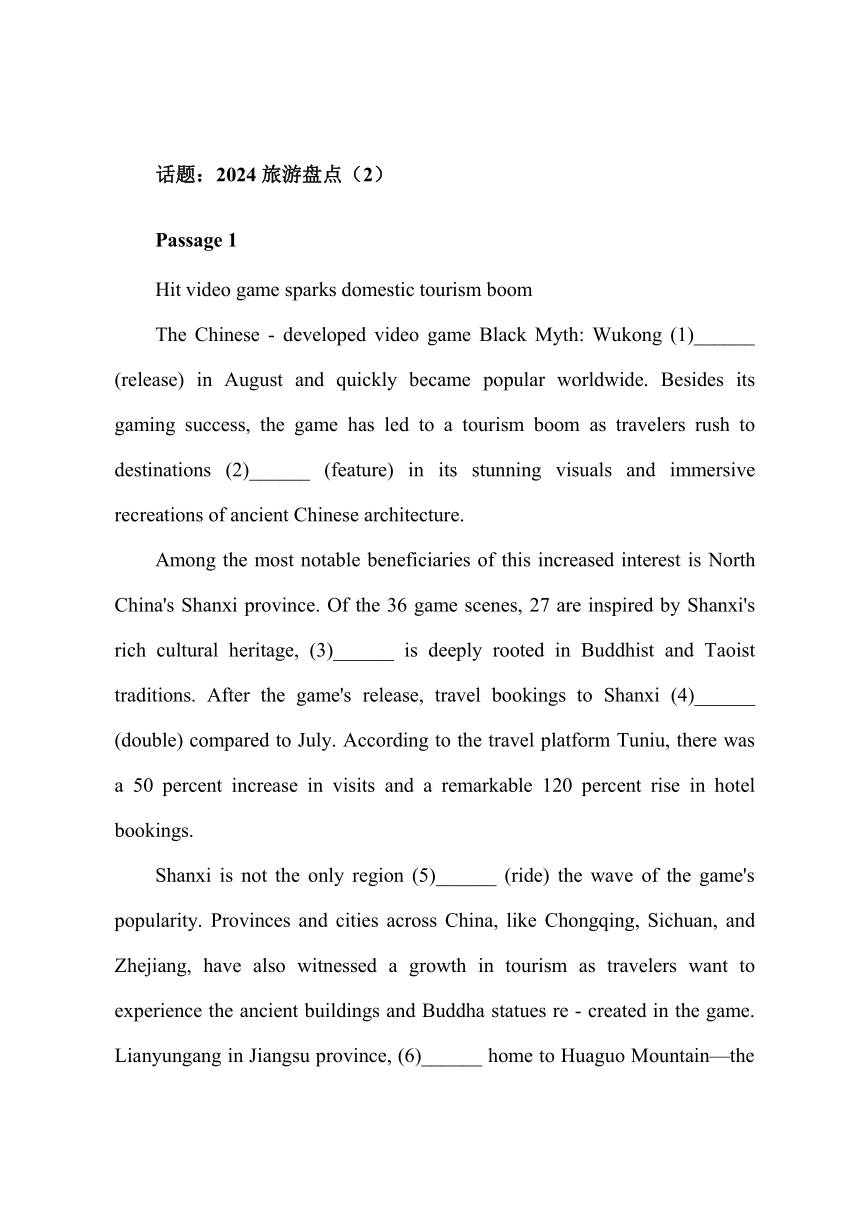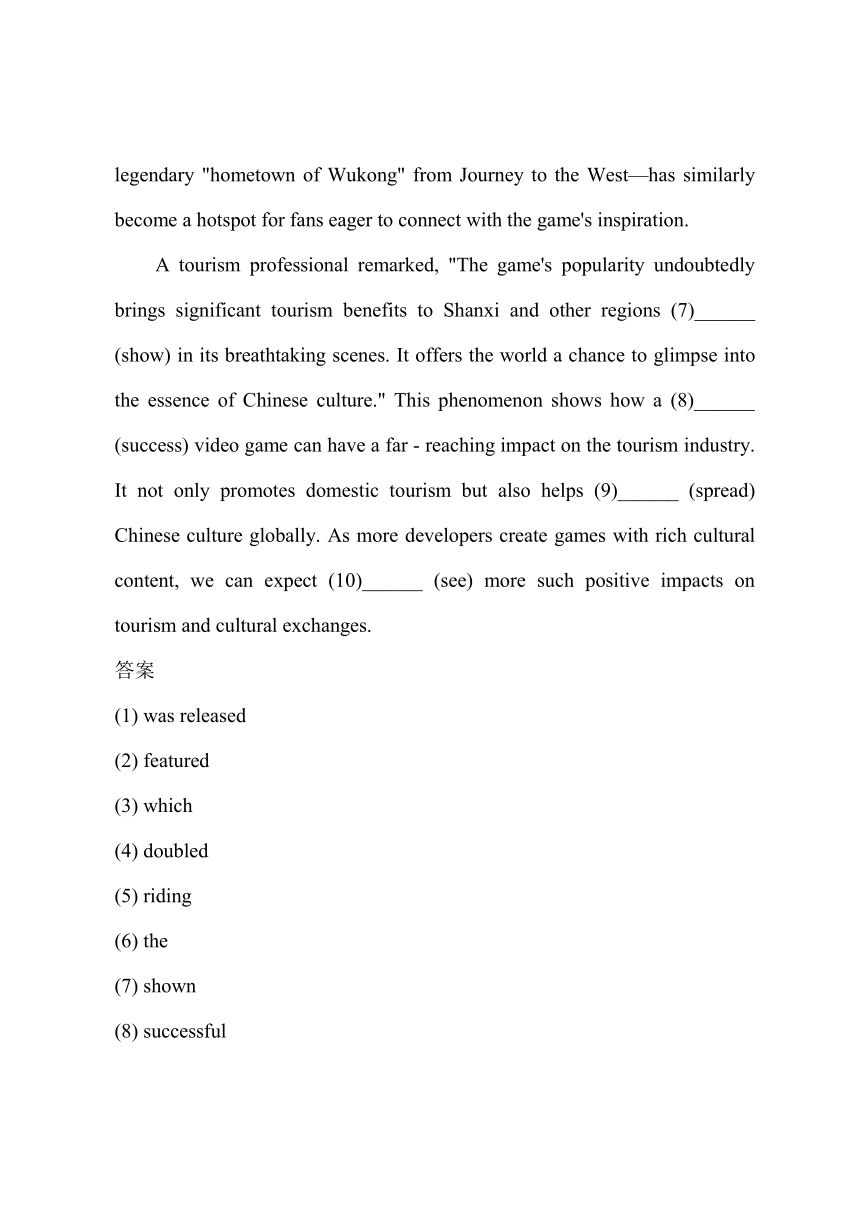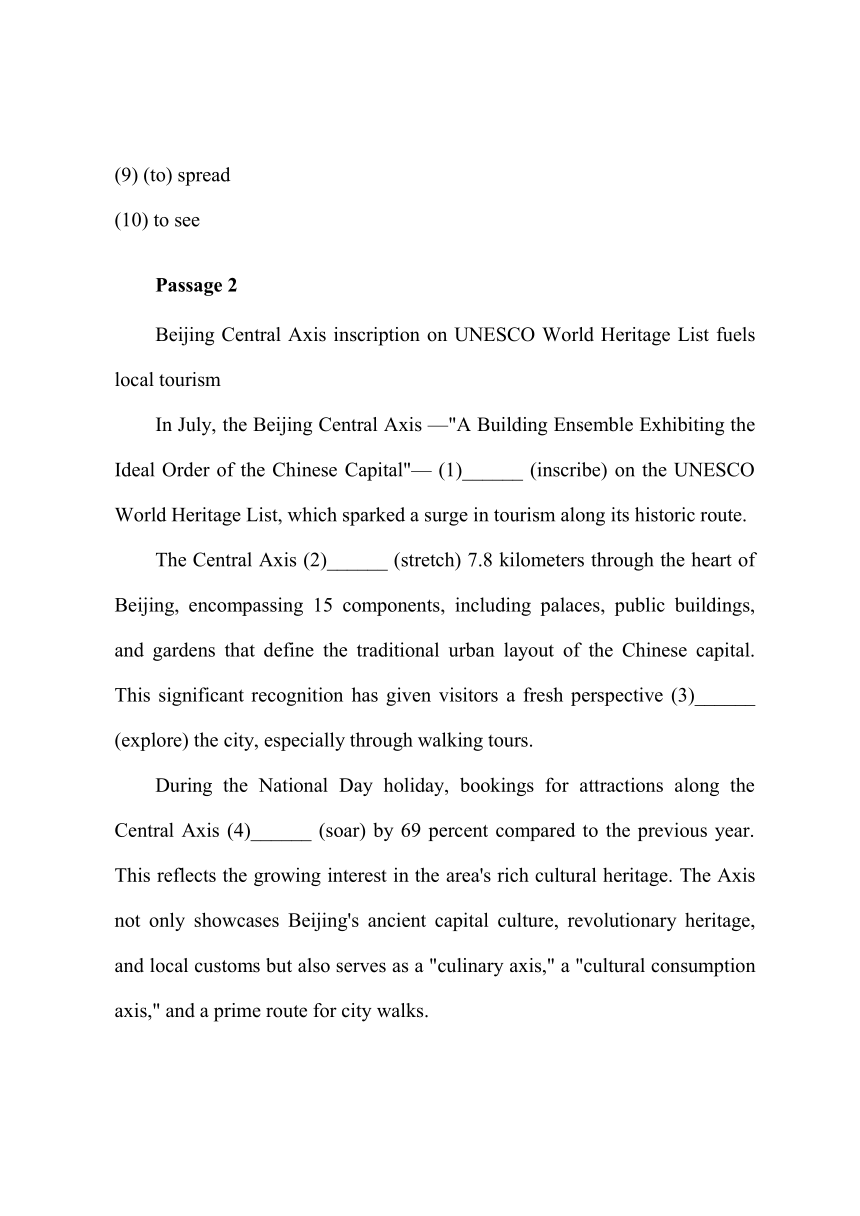China Daily 语法填空 1.3 2024 旅游盘点(2)(3篇,含答案)-2025届高三上学期英语一轮复习专项
文档属性
| 名称 | China Daily 语法填空 1.3 2024 旅游盘点(2)(3篇,含答案)-2025届高三上学期英语一轮复习专项 |  | |
| 格式 | docx | ||
| 文件大小 | 18.3KB | ||
| 资源类型 | 教案 | ||
| 版本资源 | 人教版(2019) | ||
| 科目 | 英语 | ||
| 更新时间 | 2025-01-04 16:47:56 | ||
图片预览



文档简介
话题:2024旅游盘点(2)
Passage 1
Hit video game sparks domestic tourism boom
The Chinese - developed video game Black Myth: Wukong (1)______ (release) in August and quickly became popular worldwide. Besides its gaming success, the game has led to a tourism boom as travelers rush to destinations (2)______ (feature) in its stunning visuals and immersive recreations of ancient Chinese architecture.
Among the most notable beneficiaries of this increased interest is North China's Shanxi province. Of the 36 game scenes, 27 are inspired by Shanxi's rich cultural heritage, (3)______ is deeply rooted in Buddhist and Taoist traditions. After the game's release, travel bookings to Shanxi (4)______ (double) compared to July. According to the travel platform Tuniu, there was a 50 percent increase in visits and a remarkable 120 percent rise in hotel bookings.
Shanxi is not the only region (5)______ (ride) the wave of the game's popularity. Provinces and cities across China, like Chongqing, Sichuan, and Zhejiang, have also witnessed a growth in tourism as travelers want to experience the ancient buildings and Buddha statues re - created in the game. Lianyungang in Jiangsu province, (6)______ home to Huaguo Mountain—the legendary "hometown of Wukong" from Journey to the West—has similarly become a hotspot for fans eager to connect with the game's inspiration.
A tourism professional remarked, "The game's popularity undoubtedly brings significant tourism benefits to Shanxi and other regions (7)______ (show) in its breathtaking scenes. It offers the world a chance to glimpse into the essence of Chinese culture." This phenomenon shows how a (8)______ (success) video game can have a far - reaching impact on the tourism industry. It not only promotes domestic tourism but also helps (9)______ (spread) Chinese culture globally. As more developers create games with rich cultural content, we can expect (10)______ (see) more such positive impacts on tourism and cultural exchanges.
答案
(1) was released
(2) featured
(3) which
(4) doubled
(5) riding
(6) the
(7) shown
(8) successful
(9) (to) spread
(10) to see
Passage 2
Beijing Central Axis inscription on UNESCO World Heritage List fuels local tourism
In July, the Beijing Central Axis —"A Building Ensemble Exhibiting the Ideal Order of the Chinese Capital"— (1)______ (inscribe) on the UNESCO World Heritage List, which sparked a surge in tourism along its historic route.
The Central Axis (2)______ (stretch) 7.8 kilometers through the heart of Beijing, encompassing 15 components, including palaces, public buildings, and gardens that define the traditional urban layout of the Chinese capital. This significant recognition has given visitors a fresh perspective (3)______ (explore) the city, especially through walking tours.
During the National Day holiday, bookings for attractions along the Central Axis (4)______ (soar) by 69 percent compared to the previous year. This reflects the growing interest in the area's rich cultural heritage. The Axis not only showcases Beijing's ancient capital culture, revolutionary heritage, and local customs but also serves as a "culinary axis," a "cultural consumption axis," and a prime route for city walks.
Visitors are increasingly attracted to slow - paced tourism activities like cycling and walking tours, (5)______ cater to their desire for immersive and personalized travel experiences. Additionally, over 80 creative cultural products inspired by the Central Axis—such as cultural badges, traditional mortise - and - tenon models, and fridge magnets—have become popular souvenirs, (6)______ (reflect) the growing enthusiasm for this iconic route.
The inscription of the Beijing Central Axis has not only reaffirmed its historical and cultural significance but also revitalized tourism, making it a key cultural destination for both domestic and international visitors. It shows how the recognition of cultural heritage can have a positive impact (7)______ the local tourism industry. The Central Axis, with (8)______ long history and rich cultural connotations, has always been an important part of Beijing. Now, more people can experience its charm. As the government and relevant departments continue to promote the protection and development of the Central Axis, we can expect (9)______ (see) more tourists coming to explore this unique place. It is also hoped that this will further enhance the (10)______ (aware) of cultural heritage protection among the public.
答案
(1)was inscribed
(2) stretches
(3) to explore
(4) soared
(5) which
(6) reflecting
(7) on
(8) its
(9) to see
(10) awareness
Passage 3
Tianshui's malatang magic: How a viral dish transformed a city into a tourist haven
The power of social media has turned the unassuming city of Tianshui in Northwest China's Gansu province into an unexpected tourism hotspot, all due to its signature dish: the fiery malatang hotpot.
In February, a local resident's short video (1)______ (showcase) malatang went viral, (2)______ (amass) 1.69 million shares on a popular platform. The dish's sudden fame caught the attention of food enthusiasts and social media influencers, many of (3)______ flocked to Tianshui to explore its culinary delights and share their experiences online.
The viral phenomenon has brought tangible results to the local tourism industry. In March alone, Tianshui (4)______ (welcome) 4.64 million visitors, generating 2.7 billion yuan ($370 million) in tourism revenue—a year - on - year increase of 64.8 percent and 67.2 percent, respectively.
To accommodate the influx of tourists, Tianshui residents and authorities adopted a "guest - first" approach. Local volunteers organized free transport services, (5)______ (clean) the city overnight, refreshed walls and roads, and even launched a "malatang express bus line." The city also hosted a malatang food festival and gave away local specialties and creative cultural souvenirs to visiting fans.
Tianshui's story is a testament to how culinary culture, (6)______ (amplify) by social media, can transform a small city into a viral travel destination. With its warm hospitality and irresistible malatang, Tianshui is now firmly on the map as a must - visit destination for food lovers across China. It shows that even a small - scale local dish can have a huge impact on a city's tourism. The success of Tianshui also lies in the joint efforts of its residents and authorities. They realized the potential of the viral dish and took timely actions to (7)______ (well) the tourism experience. By providing better services and organizing various activities, they not only satisfied the tourists but also enhanced the city's image. In the future, more cities may learn from Tianshui's experience and find their own unique ways to promote tourism. They can focus on their local cultural (8)______ (treasure), whether it's food, handicrafts, or traditional festivals, and use modern media platforms to attract more visitors. As the tourism industry continues to develop, it's important for cities to keep innovating and (9)______ (improve) to meet the changing needs of tourists. Tianshui has set a good example in this regard, and we can expect to see more such (10)______ (success) stories in the future.
答案
(1) showcasing
(2) amassing
(3) whom
(4) welcomed
(5) cleaned
(6) amplified
(7) better
(8) treasures
(9) improving
(10) successful
Passage 1
Hit video game sparks domestic tourism boom
The Chinese - developed video game Black Myth: Wukong (1)______ (release) in August and quickly became popular worldwide. Besides its gaming success, the game has led to a tourism boom as travelers rush to destinations (2)______ (feature) in its stunning visuals and immersive recreations of ancient Chinese architecture.
Among the most notable beneficiaries of this increased interest is North China's Shanxi province. Of the 36 game scenes, 27 are inspired by Shanxi's rich cultural heritage, (3)______ is deeply rooted in Buddhist and Taoist traditions. After the game's release, travel bookings to Shanxi (4)______ (double) compared to July. According to the travel platform Tuniu, there was a 50 percent increase in visits and a remarkable 120 percent rise in hotel bookings.
Shanxi is not the only region (5)______ (ride) the wave of the game's popularity. Provinces and cities across China, like Chongqing, Sichuan, and Zhejiang, have also witnessed a growth in tourism as travelers want to experience the ancient buildings and Buddha statues re - created in the game. Lianyungang in Jiangsu province, (6)______ home to Huaguo Mountain—the legendary "hometown of Wukong" from Journey to the West—has similarly become a hotspot for fans eager to connect with the game's inspiration.
A tourism professional remarked, "The game's popularity undoubtedly brings significant tourism benefits to Shanxi and other regions (7)______ (show) in its breathtaking scenes. It offers the world a chance to glimpse into the essence of Chinese culture." This phenomenon shows how a (8)______ (success) video game can have a far - reaching impact on the tourism industry. It not only promotes domestic tourism but also helps (9)______ (spread) Chinese culture globally. As more developers create games with rich cultural content, we can expect (10)______ (see) more such positive impacts on tourism and cultural exchanges.
答案
(1) was released
(2) featured
(3) which
(4) doubled
(5) riding
(6) the
(7) shown
(8) successful
(9) (to) spread
(10) to see
Passage 2
Beijing Central Axis inscription on UNESCO World Heritage List fuels local tourism
In July, the Beijing Central Axis —"A Building Ensemble Exhibiting the Ideal Order of the Chinese Capital"— (1)______ (inscribe) on the UNESCO World Heritage List, which sparked a surge in tourism along its historic route.
The Central Axis (2)______ (stretch) 7.8 kilometers through the heart of Beijing, encompassing 15 components, including palaces, public buildings, and gardens that define the traditional urban layout of the Chinese capital. This significant recognition has given visitors a fresh perspective (3)______ (explore) the city, especially through walking tours.
During the National Day holiday, bookings for attractions along the Central Axis (4)______ (soar) by 69 percent compared to the previous year. This reflects the growing interest in the area's rich cultural heritage. The Axis not only showcases Beijing's ancient capital culture, revolutionary heritage, and local customs but also serves as a "culinary axis," a "cultural consumption axis," and a prime route for city walks.
Visitors are increasingly attracted to slow - paced tourism activities like cycling and walking tours, (5)______ cater to their desire for immersive and personalized travel experiences. Additionally, over 80 creative cultural products inspired by the Central Axis—such as cultural badges, traditional mortise - and - tenon models, and fridge magnets—have become popular souvenirs, (6)______ (reflect) the growing enthusiasm for this iconic route.
The inscription of the Beijing Central Axis has not only reaffirmed its historical and cultural significance but also revitalized tourism, making it a key cultural destination for both domestic and international visitors. It shows how the recognition of cultural heritage can have a positive impact (7)______ the local tourism industry. The Central Axis, with (8)______ long history and rich cultural connotations, has always been an important part of Beijing. Now, more people can experience its charm. As the government and relevant departments continue to promote the protection and development of the Central Axis, we can expect (9)______ (see) more tourists coming to explore this unique place. It is also hoped that this will further enhance the (10)______ (aware) of cultural heritage protection among the public.
答案
(1)was inscribed
(2) stretches
(3) to explore
(4) soared
(5) which
(6) reflecting
(7) on
(8) its
(9) to see
(10) awareness
Passage 3
Tianshui's malatang magic: How a viral dish transformed a city into a tourist haven
The power of social media has turned the unassuming city of Tianshui in Northwest China's Gansu province into an unexpected tourism hotspot, all due to its signature dish: the fiery malatang hotpot.
In February, a local resident's short video (1)______ (showcase) malatang went viral, (2)______ (amass) 1.69 million shares on a popular platform. The dish's sudden fame caught the attention of food enthusiasts and social media influencers, many of (3)______ flocked to Tianshui to explore its culinary delights and share their experiences online.
The viral phenomenon has brought tangible results to the local tourism industry. In March alone, Tianshui (4)______ (welcome) 4.64 million visitors, generating 2.7 billion yuan ($370 million) in tourism revenue—a year - on - year increase of 64.8 percent and 67.2 percent, respectively.
To accommodate the influx of tourists, Tianshui residents and authorities adopted a "guest - first" approach. Local volunteers organized free transport services, (5)______ (clean) the city overnight, refreshed walls and roads, and even launched a "malatang express bus line." The city also hosted a malatang food festival and gave away local specialties and creative cultural souvenirs to visiting fans.
Tianshui's story is a testament to how culinary culture, (6)______ (amplify) by social media, can transform a small city into a viral travel destination. With its warm hospitality and irresistible malatang, Tianshui is now firmly on the map as a must - visit destination for food lovers across China. It shows that even a small - scale local dish can have a huge impact on a city's tourism. The success of Tianshui also lies in the joint efforts of its residents and authorities. They realized the potential of the viral dish and took timely actions to (7)______ (well) the tourism experience. By providing better services and organizing various activities, they not only satisfied the tourists but also enhanced the city's image. In the future, more cities may learn from Tianshui's experience and find their own unique ways to promote tourism. They can focus on their local cultural (8)______ (treasure), whether it's food, handicrafts, or traditional festivals, and use modern media platforms to attract more visitors. As the tourism industry continues to develop, it's important for cities to keep innovating and (9)______ (improve) to meet the changing needs of tourists. Tianshui has set a good example in this regard, and we can expect to see more such (10)______ (success) stories in the future.
答案
(1) showcasing
(2) amassing
(3) whom
(4) welcomed
(5) cleaned
(6) amplified
(7) better
(8) treasures
(9) improving
(10) successful
